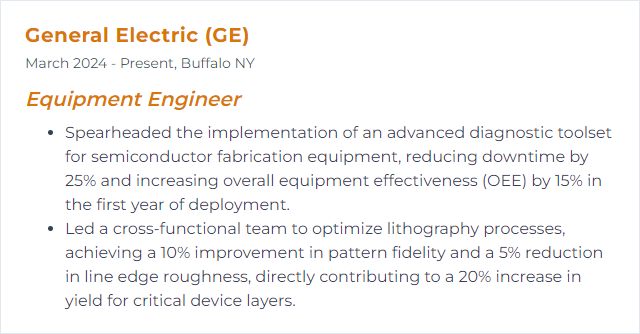Top 12 Equipment Engineer Skills to Put on Your Resume
In today’s hiring scramble, standing out as an equipment engineer means showing sharp technical judgment and steady people skills on your resume. Put your most relevant tools, methods, and systems up front. Make it obvious you can design smart, solve wicked problems, and keep operations humming without drama.
Equipment Engineer Skills
- AutoCAD
- SolidWorks
- PLC Programming
- Six Sigma
- Lean Manufacturing
- MATLAB
- SCADA Systems
- P&ID Interpretation
- FMEA Analysis
- ISO Standards
- Robotics Integration
- Semiconductor Fabrication
1. AutoCAD
AutoCAD is CAD software used to draft and detail equipment, machine parts, and systems with precise 2D drawings and robust 3D models, plus clean documentation.
Why It's Important
It lets an Equipment Engineer design, tweak, and validate equipment accurately, align with standards, and hand off build-ready documents—fewer errors, faster cycles, lower cost.
How to Improve AutoCAD Skills
Sharpen your workflow and depth:
Lock the fundamentals: Core commands, layers, blocks, constraints, external references. Speed lives here.
Customize the workspace: Tool palettes, shortcuts, ribbons, and templates tuned to your parts and plant standards.
Go 3D with purpose: Model for manufacturability and maintenance access. Use parametrics to drive change cleanly.
Explode less, reference more: Dynamic blocks and reusable libraries keep drawings consistent and quick to update.
Standards and annotations: Dimension styles, GD&T, title blocks, and revision control that match your company spec.
Practice on real constraints: Tolerances, clearances, lifting points, install paths—design so it fits, ships, and runs.
Stay current: New features often cut clicks. Learn them, adopt them, retire old habits.
Better models. Clearer drawings. Fewer surprises on the shop floor.
How to Display AutoCAD Skills on Your Resume

2. SolidWorks
SolidWorks is a 3D CAD and simulation platform for creating parts, assemblies, and production drawings of machinery and equipment.
Why It's Important
It delivers fast iteration, interference checks, motion studies, and simulation to de-risk designs before metal gets cut.
How to Improve SolidWorks Skills
Turn design time into decision time:
Model with intent: Parametric sketches, robust mates, smart patterns. Fewer rebuild headaches.
Large assembly hygiene: Lightweight modes, configurations, display states, and simplified envelopes.
Drawings that communicate: Clean views, model items, weld symbols, GD&T, BOMs linked to metadata.
Simulation as a filter: Quick FEA for stiffness, thermal, vibration—catch the weak links early.
Automation: Templates, macros, design tables, and API where repetition drags.
Data discipline: PDM/PLM usage for versions, approvals, and traceability.
Precision models turn into accurate builds. That’s the job.
How to Display SolidWorks Skills on Your Resume
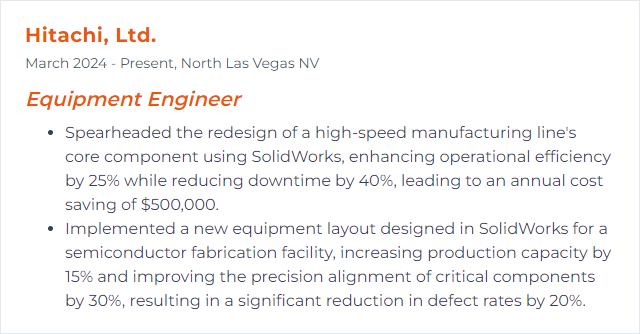
3. PLC Programming
PLC programming creates the logic that drives automated machines and process lines—safe, deterministic control with tight timing and diagnostics.
Why It's Important
It’s the heartbeat of modern equipment. Reliable control minimizes downtime, improves throughput, and protects people and assets.
How to Improve PLC Programming Skills
Build clarity, resilience, and safety into the code and the panel:
Master core languages: Ladder, Structured Text, Function Block. Use each where it shines.
Standards first: IEC 61131-3 conventions, tag naming, modular routines, and comments that future you can read.
Solid I/O design: Debounce strategy, scaling, diagnostics, and safe states on loss of signal.
State machines: Clear modes (auto, manual, maintenance), interlocks, permissives, and fault handling.
HMI that helps: Alarm rationalization, trend views, guided recovery, and meaningful messages.
Networking: Industrial Ethernet, fieldbuses (Profinet, EtherNet/IP), time sync, and segmentation.
Test like it matters: Simulation, unit tests for functions, factory acceptance tests, and robust change control.
Safety: SIL evaluation, safe I/O, e-stops, light curtains, and validation against machine safety standards.
Clean logic beats clever logic when you’re chasing faults at 2 a.m.
How to Display PLC Programming Skills on Your Resume
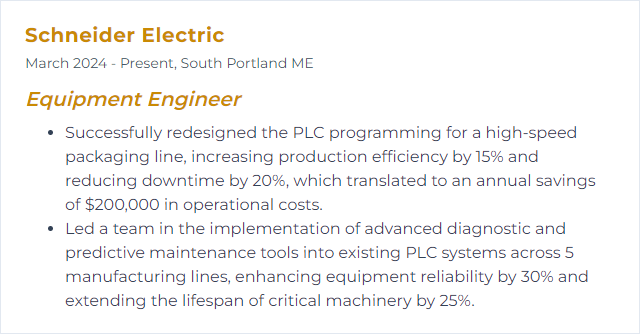
4. Six Sigma
Six Sigma is a data-driven method to cut defects and variation using DMAIC, statistical tools, and disciplined project execution.
Why It's Important
For equipment, it means fewer breakdowns, tighter processes, and predictable output—quality that sticks.
How to Improve Six Sigma Skills
Make the data do the talking:
Measurement systems first: MSA and gauge R&R so your numbers aren’t lying.
SPC where it counts: Control charts on critical features, alarms before scrap erupts.
DMAIC with teeth: Define the CTQs, analyze root causes, validate improvements with pilot runs, then lock controls.
Predictive thinking: Pair condition monitoring with analytics for downtime prevention.
DOE: Factorial experiments to tune recipes, cycle times, and tolerances.
Standard work + visual controls: Errors get obvious; recovery gets fast.
Capability in the loop: Cp/Cpk targets baked into acceptance criteria for equipment and processes.
Variation shrinks. Yield climbs. Noise fades.
How to Display Six Sigma Skills on Your Resume
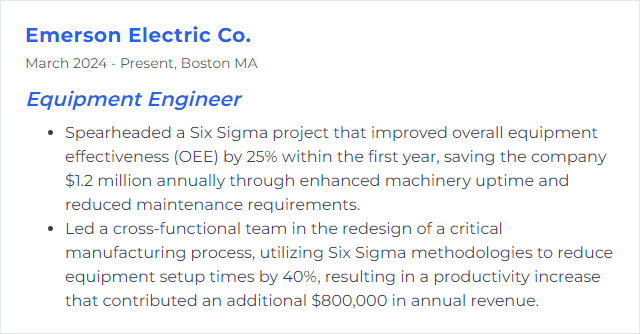
5. Lean Manufacturing
Lean trims waste and amplifies flow—equipment, materials, people, and information moving smoothly to deliver value.
Why It's Important
For an Equipment Engineer, lean means machines that start faster, stop less, change over quicker, and produce with fewer touches.
How to Improve Lean Manufacturing Skills
Make the process lighter and faster:
- Kaizen cadence: Small fixes daily, not big fixes someday.
- Value Stream Mapping: See the bottlenecks and queues; target the constraint.
- TPM: OEE visibility, autonomous maintenance, and planned PM that actually prevents.
- 5S: Orderliness that saves seconds and prevents mishaps.
- Jidoka: Stop on abnormal; build in detection and containment.
- SMED: Ruthless changeover reduction—externalize, standardize, quick-release.
- Pull systems: Kanban and right-sized batches to smooth flow.
Less friction, more throughput. The line breathes easier.
How to Display Lean Manufacturing Skills on Your Resume
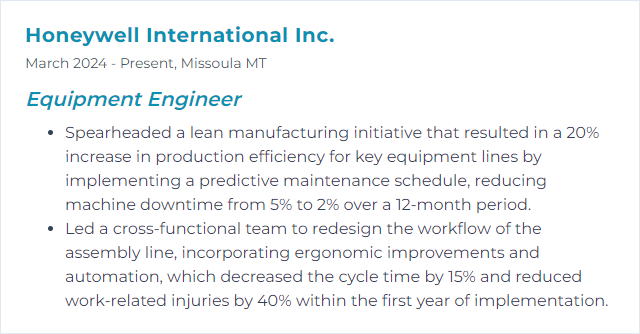
6. MATLAB
MATLAB is a high-level environment for numerical computing, data analysis, controls, and simulation—often paired with Simulink for dynamic systems.
Why It's Important
It accelerates modeling, tuning, and troubleshooting of equipment performance with fast visualization and testable algorithms.
How to Improve MATLAB Skills
Turn messy data into clean decisions:
- Core fluency: Vectors, matrices, tables, and function handles without stumbling.
- Toolboxes that matter: Signal processing, control systems, optimization, and statistics for real plant data.
- Visualization: Quick plots, dashboards, live scripts to tell the story.
- Automation: Scripts, functions, and apps that remove manual grunt work.
- Performance: Preallocation, vectorization, and profiler-driven speedups.
- Hardware ties: Instrument I/O, data acquisition, and real-time testing when the bench beckons.
- Verification: Unit tests, version control, and reproducible analysis.
From prototype to proof, faster.
How to Display MATLAB Skills on Your Resume
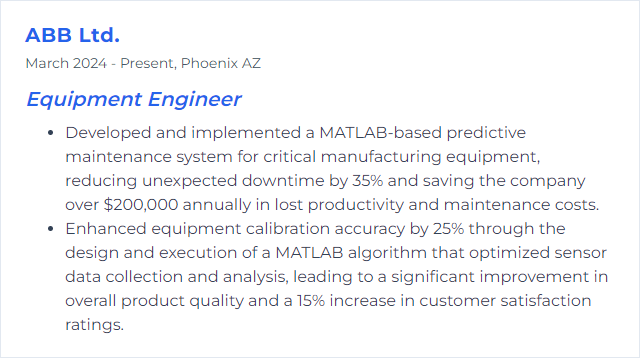
7. SCADA Systems
SCADA (Supervisory Control and Data Acquisition) centralizes monitoring, control, and alarming for industrial equipment, collecting real-time data from distributed devices.
Why It's Important
Engineers see the plant in one pane, act quickly, and keep operations safe, efficient, and visible.
How to Improve SCADA Systems Skills
Make it reliable, secure, and human-friendly:
Defense-in-depth: Network segmentation, least privilege, patching, and rigorous account control aligned with industrial cybersecurity frameworks.
High availability: Redundant servers, historians, comms paths, and graceful failover testing.
Protocol savvy: OPC UA, Modbus, DNP3, MQTT—choose, secure, and validate.
Alarm management: Prioritize, shelve properly, kill alarm floods. Measure alarm rates and response.
Usable HMIs: High-performance graphics, clear trends, and guided diagnostics.
Data to value: Historian retention, analytics, and alerts that predict—not just report.
Compliance and standards: Align with IEC 62443 and related guidance; document architectures and changes.
Training: Drills for abnormal scenarios and playbooks for rapid recovery.
When the system blips, operators shouldn’t.
How to Display SCADA Systems Skills on Your Resume

8. P&ID Interpretation
P&IDs map process flow, equipment, lines, instruments, and controls—your blueprint for how a system breathes and behaves.
Why It's Important
Correct interpretation keeps designs accurate, startups smooth, and troubleshooting targeted and safe.
How to Improve P&ID Interpretation Skills
Read fast, read right:
Know the symbols: ISA-5.1 conventions, line types, valve bodies, instrument bubbles, and function tags.
Trace the flow: From feed to finish—normal, startup, shutdown, and bypass paths.
Decode tags: Equipment IDs, loop numbers, service, and setpoints that tie to the asset list.
Controls context: Understand interlocks, permissives, and control strategies implied on the diagram.
Walk the plant: Field-verify against the drawing; note redlines, then reconcile.
Cross-reference: Match P&IDs with PFDs, Piping Specs, and Cause & Effect matrices.
From paper to pipe, alignment matters.
How to Display P&ID Interpretation Skills on Your Resume
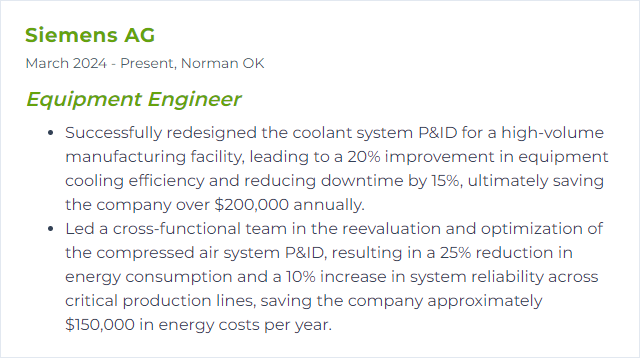
9. FMEA Analysis
FMEA (Failure Modes and Effects Analysis) systematically hunts for ways systems can fail, estimates risk, and drives mitigations before trouble lands.
Why It's Important
It boosts reliability, trims cost of failure, and documents risk thinking that auditors and customers trust.
How to Improve FMEA Analysis Skills
Make it living, not a checkbox:
Right team: Design, manufacturing, quality, maintenance—the full picture.
Good inputs: Field failure data, warranty, test results, and supplier feedback.
Sharp prioritization: RPN plus criticality; focus on severity first for safety concerns.
Actionable controls: Prevention over detection; verify effectiveness and close the loop.
Tie to change: Review FMEAs at ECNs, major process shifts, or new failure learnings.
Traceability: Link failure modes to control plans, test protocols, and maintenance tasks.
Find it on paper, not on the production floor.
How to Display FMEA Analysis Skills on Your Resume
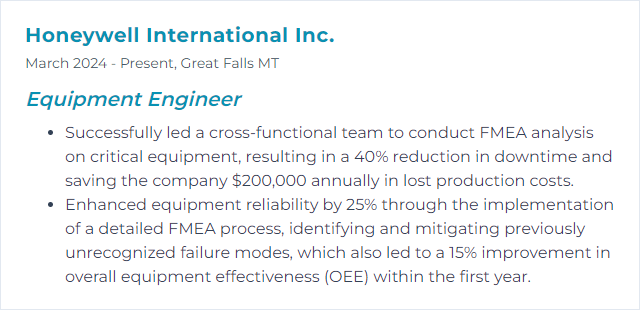
10. ISO Standards
ISO standards define common rules for quality, safety, and consistency. Think ISO 9001 (QMS), ISO 14001 (environment), ISO 45001 (safety), ISO 12100 (machine safety), ISO 17025 (testing), among others.
Why It's Important
They enable equipment and processes that are safe, auditable, and globally accepted—less rework, smoother compliance.
How to Improve ISO Standards Skills
Go from “aware” to “embedded”:
Know the clauses: Map requirements to your equipment lifecycle—design, procurement, commissioning, maintenance.
Document what you do: Procedures, SOPs, work instructions, and records that match reality.
Risk-based thinking: FMEA, HACCP-like approaches, and corrective actions tied to measurable outcomes.
Internal audits: Schedule, sample, and report with clear findings and owners.
Supplier alignment: Specifications, PPAPs where applicable, and incoming inspection plans.
Training and competence: Matrix of skills, refresh cycles, and verification.
Management of change: Engineering changes assessed for safety, compliance, and documentation updates.
Compliance becomes culture when it’s baked into daily work.
How to Display ISO Standards Skills on Your Resume

11. Robotics Integration
Robotics integration blends robots, tooling, vision, safety, and control into a production line that meets cycle time and quality goals.
Why It's Important
It boosts precision, consistency, and uptime—while freeing people from repetitive, risky tasks.
How to Improve Robotics Integration Skills
Design for throughput and safety from day one:
Requirements nailed: Payloads, reach, tolerances, rate, and uptime targets documented up front.
Simulation first: Off-line programming, reach studies, and collision checks before steel.
Tooling and vision: EOAT that’s rigid, light, and serviceable; vision lighting and calibration that don’t drift.
Controls harmony: PLC/robot handshakes, safe zones, interlocks, and clear fault recovery.
Safety standards: Design and validate to ISO 10218/TS 15066 and relevant machine safety guidelines.
Changeover strategy: Quick swaps, recipes, and mistake-proofing for variants.
Lifecycle plan: Spares, PM tasks, and training so the cell stays sharp.
A well-integrated cell feels boring. That’s a compliment.
How to Display Robotics Integration Skills on Your Resume

12. Semiconductor Fabrication
Semiconductor fabrication builds integrated circuits on wafers through deposition, lithography, etch, implant, and clean—inside relentless process controls.
Why It's Important
Equipment choices and upkeep make or break yield, throughput, and device performance—tiny drifts, huge consequences.
How to Improve Semiconductor Fabrication Skills
Stability and yield are the north stars:
Process windows: SPC on critical steps; react to trends before excursions bite.
Preventive and predictive maintenance: Condition monitoring, parts lifing, and disciplined PM execution.
Tool qualification: Golden recipes, matching strategies, and rigorous acceptance tests.
Contamination control: Cleanroom behavior, FOUP/SMIF discipline, particle and AMC vigilance.
Metrology feedback: Fast measurements feeding APC and run-to-run control.
Continuous upgrade path: Software revisions, better chamber hardware, improved chemistries—evaluated and validated.
Precision isn’t optional here; it’s survival.
How to Display Semiconductor Fabrication Skills on Your Resume
